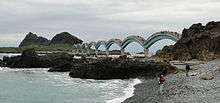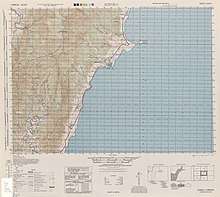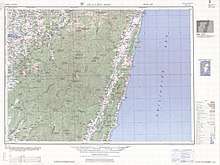Sanxiantai
Sanxiantai[1] (Amis: nuwalian; Chinese: 三仙台; pinyin: Sānxiāntái) is an area containing a beach and several islands located on the coast of Chenggong Township, Taitung County, Taiwan. The beach stretches for ten kilometers in length. It is situated at the 112-kilometer mark. A popular tourist attraction for its rocky coastal views, the area is well known for its long footbridge in the shape of a sea dragon that connects the coast to the largest island.[2] The name Sanxiantai means "three immortals platform", referring to the island with three large standing rocks.[3]

Overview
Sanxiantai means "Platform of the three immortals". Sanxiantai Island has three extremely large rocks on the island. Sanxiantai Island has a very unique shape. The area is best known for its long footbridge that connects the eastern coast of the main Island of Taiwan with the outer Island of Sanxiantai.


See also
References
- "WINTER EVENTS SANXIANTAI SUNRISE". Travel in Taiwan. Tourism Bureau, MOTC. November 2019. p. 05.
One of the best locations is Sanxiantai, a small island off the Taitung County coast, connected to the mainland by an iconic eight-arch footbridge.
- "Sansiantai". Tour.taitung.gov.tw. Retrieved 2014-05-14.
- "Sanxiantai Dragon Bridge in Taitung, Taiwan". EXPLORE TRAVELER. Retrieved 18 February 2019.